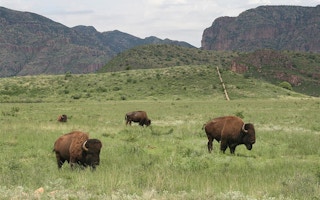Now looms a far bigger threat: President Trump’s promised “big, beautiful wall” aimed at stopping undocumented human migration and drug trafficking along the entire U.S.-Mexico border. That much-debated structure is currently a key bargaining chip, and sticking point, in immigration negotiations taking place this week between Republicans and Democrats in the U.S. Congress. By many accounts, the negotiations are wide open, but the pressure is on to reach an agreement by March 5. That’s when Trump is terminating the Deferred Action for Childhood Arrivals program (DACA), which has been protecting unauthorized immigrants brought to the U.S. as children from deportation. But the president has said he is willing to reinstate the program if he receives $25 billion for his wall in exchange, to be spent over ten years.
As recently as February 5 Trump tweeted: “Any deal on DACA that does not include STRONG border security and the desperately needed WALL is a total waste of time. March 5th is rapidly approaching and the Dems seem not to care about DACA. Make a deal!”
List and other Mexican scientists and conservationists are very concerned about whether or not the U.S. will decide to build its mega-wall. Small picture: a nearly impermeable border wall in the Janos Valley will stop most wildlife in their tracks and gravely threaten Mexican populations of bison, pronghorn, and bighorn sheep. Big picture: a wall running the entire nearly 2,000-mile frontier from the Pacific Ocean to the Gulf of Mexico, List and other conservationists warn, would be catastrophic for borderland ecosystems and many wildlife species, undoing years of environmental cooperation between the two countries to protect animals that must move freely or die.
If Trump’s wall is built, “this barrier will rewrite the biological history of North America. A history that for millennia allowed animals to travel along the grasslands and forests from Mexico to Canada,” List wrote in an issue of Jornada Ecologica. “The future of the bison and many other species that the two countries share is at stake at the border.”
Wall-to-wall problems with Trump’s wall
Notably, Trump didn’t originate this north-south wildlife connectivity conundrum, though his plan promises to greatly magnify it. About one-third of the border already has one of three kinds of fencing [pdf]. There are 300 miles of low vehicle barriers (such as the already mentioned Normandy barriers), which are relatively permeable for most species. The remaining 405 miles consists of formidable walls, typically 15 feet or more high (4.5 meters), called pedestrian fencing. In some places these walls are doubled or even tripled, destroying connectivity.
The George W. Bush administration waived numerous environmental laws to erect most of this infrastructure in the mid-2000s, to conservationists’ deep and abiding dismay. Activists have since vocally opposed wall building on environmental, humanitarian, budgetary and practical grounds, and analysts have questioned whether a full wall, as Trump envisions it, could ever be built; some Bush-era attempts to seize private land for wall construction are still tied up in court. There are even signs Trump may be willing to settle for something less than the coast-to-coast structure he’s been hawking.
Nevertheless, the Trump administration has largely remained adamant, and pushed ahead with total disregard for environmental considerations. It commissioned eight 30-foot tall wall prototypes near San Diego that would certainly block most Earth-bound wildlife. The administration also has already waived dozens of environmental laws in several places in order to proceed. It has declared its intent to waive U.S. Endangered Species Act protections for jaguar to build walls across habitat specially designated for the species. And the administration announced plans to start its wall-building by erecting fence right through the heart of the Santa Ana National Wildlife Refuge in Texas, provoking a large protest.
Asked whether U.S. Customs and Border Protection (CBP), the agency in charge of border infrastructure, would conduct any environmental review for its wall projects, Carlos Diaz, the agency’s southwest branch chief, told Mongabay that it would follow procedures similar to what it did during the Bush era. In an email, Diaz conveyed the following statement from CBP officials:
CBP is committed to responsible environmental stewardship in the implementation of its border security infrastructure projects. CBP will utilize existing data where present as well as conduct natural and cultural resources surveys of project areas where no data currently exists. In addition, CBP will prepare environmental planning documents that evaluate the environmental impacts from the execution of the project…. Environmental planning of border security infrastructure projects will analyze whether the construction footprint will have indirect or direct effects on threatened or endangered species or their habitats. In addition, CBP incorporates design elements that take into consideration water ways such as rivers or ephemeral washes.
Diaz pointed to two examples of places where the agency installed features in a total of 71 miles of border fencing to allow wildlife to pass. However, many conservationists don’t think much of how CBP handles environmental reviews when it is not bound by environmental laws. Dan Millis, borderlands program coordinator with the Sierra Club’s Grand Canyon chapter in Tucson, Arizona, wrote in an email:
Under the waiver, CBP’s environmental planning documents are window dressing, to put it nicely. They hire a contractor to write non-descript paragraphs about species of concern in a project area, but many key species are often omitted. The alternatives considered are sorely lacking, meaning that CBP only provides two alternatives: the proposed action or no action. This makes it very clear that they are only trying to check off the boxes but are not complying with protection laws or consulting with impacted communities in a meaningful way.
The Sierra Club has petitioned the CBP over its “woefully inadequate planning documents” for years, Millis said. This fall the group filed suit against the U.S. Department of Homeland Security over its granting of legal waivers in building wall segments and prototypes in California.
This story was published with permission from Mongabay.com. Read the full story.










